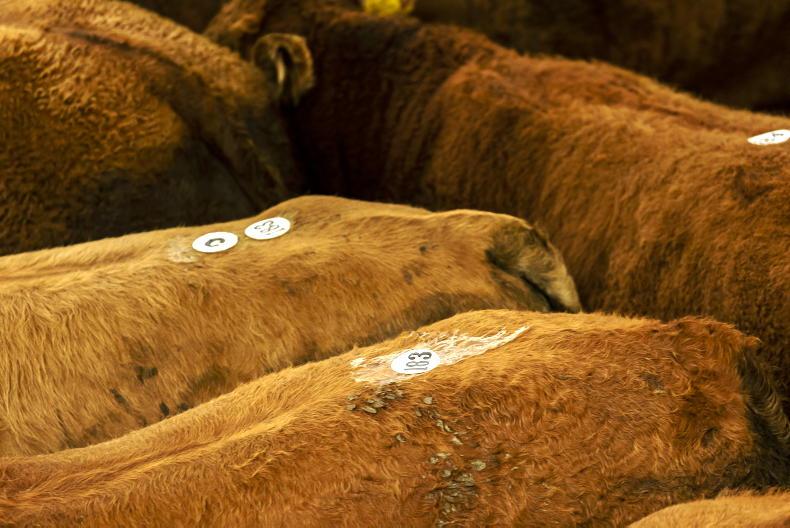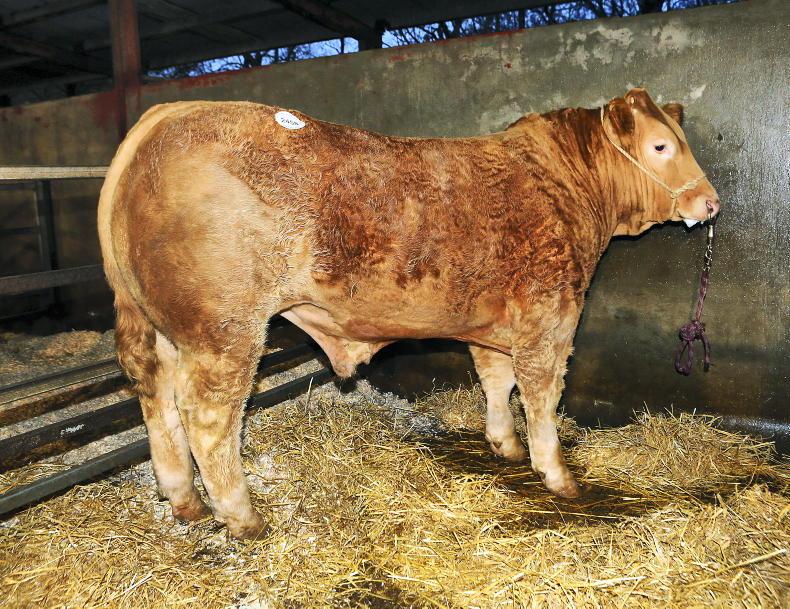On Scottish beef farms, continental breeding dominates the suckler herd. Limousin, Charolais and Simmental account for close to 60% of beef-sired calf births in 2016.
In France, where many of the beef breeds used in Scotland originate, cross-breeding is not practised. Instead, beef herds are kept pure when breeding. Does this mean French farmers are losing out on the benefits of hybrid vigour that we try to breed into our cows in here in Scotland?
On farms visited recently, it would appear not. Breeding performance and sale weights of calves was impressive. Two of the farms visited are outlined as follows:
The Charolais breeder
Olivier Pascal
Farm size: 135ha.
Herd details: 65 purebred Charolais cows.
Calving pattern: 14 November to 15 January.
Cattle system: exporting weanlings to Italy and finishing mature cows.
Olivier Pascal runs 65 purebred Charolais cows in the Auvergne region, located in the French midlands. As part of the Massif Central region of France, it is very much cattle country. Approximately 80% of farms in the region have a cattle enterprise of some sort.
The farm is a one-man unit and representative of many in the area. Land totals 135ha, most of which is in grass, although 8ha of barley is grown along with a similar area of triticale. Grain and straw are used on farm.
The cow herd calves from 14 November to 15 January and all bred to AI. Up to 15 different sires will be used on farm to test new sires and prevent inbreeding. All inseminations are carried out by an AI technician costing, on average, £36 per cow. This includes the straw and technician fee.
Breeding
Despite the pure-breeding nature of the herd, fertility is excellent, with 90% conception rates to natural heats on a single service. Stock bulls are usually home-bred bulls that will be sold on for breeding. One of these bulls will act as a sweeper where necessary.
All heifer calves are kept for breeding. Heifers will only be sold if they have poor temperament, poor fertility or a physical problem. They calve down at 36 months of age and replace 25 to 30 mature cows which are then sold on for beef. Easy calving is the main criteria when selecting AI sires, followed by maternal and carcase traits.
Sexed semen has been trialled on farm in the past but with no success. A lack of suitable sires is another issue that made it an impractical breeding option for the farm.
Marketing cattle
While heifers are held for breeding, cull cows are sold through a local co-op society for direct slaughter. Cows are marketed through the co-op under a regional brand. Mature cow size is around 900kg liveweight and they are normally sold for £1,400 to £1,800, depending on market demand.
Back in October, the local cow market was paying between £3.30kg to £3.50/kg deadweight. Cows are fattened after weaning in September on home-grown barley mixed with a general-purpose ration. The ration costs £250/tonne and barley is worth £150/t.
Bull calves are sold into two markets. Around half to two-thirds of bulls produced on farm will be sold on for breeding, as the herd is pedigree registered and using proven sires from the breed’s bull-testing station.
Information is recorded on bulls bred on farm and fed back to the society. Bulls are sold from 10 months old up to the more normal 18 months of age. Sale price is typically £2,250 for a bull sold from home, with repeat buyers in the local area purchasing a bull almost every year. The remainder of bulls are exported to Italy at nine months of age. Bulls generally weigh 400kg liveweight at sale time and generate £900 per head.
Cattle health
Cattle are vaccinated for respiratory diseases as young calves at three weeks of age and again at 10 months of age when they are weaned. Cattle are dosed once for worms using an avermectin-based product, usually in September.
Cows are housed for calving at the beginning of November and put on to a diet of haylage with 200g of meal offered, which contains pre-calving minerals.
All cows are vaccinated against scour and bedded on straw floors with access to outdoor areas in the yard, which keeps cows and heifers fit pre-calving. Sheds are cleaned out three times over winter.
After calving, cows are fed 2kg/day of a 17.5% protein ration and baled silage. Cows will not get out to grass until after 1 April due to the winter climate. Calves remain on the cows until September. Once weaned, calves are kept indoors to settle and then sold on to Italy after they have received all vaccines.
Land
Land availability is good, although accessing it can be difficult. Farmers in the local area get first refusal on land sales, followed by the wider area and then opened out to all buyers after that.
Local authorities cap land prices for sale at €2000/ha (£1,800) and rent at €200/ha (£180). There is a lack of new blood coming into the industry.
Farm subsidies total £44,600, which includes the cow headage premiums. The farm has a very low level of input costs. Around 100kg/ha of nitrogen is applied every year, which is usually urea, costing £350/t. Farmyard manure is used on 50ha of land where crops and silage are grown.
Adding value the blonde way
Bertrand Duprat
Farm size: 203ha (85ha crops, 118ha of grassland).
Herd size: 100 breeding cows.
Breeding: AI and stock bull.
Calving interval: 393 days.
System: exporting bulls and selling cows through on-farm butchery.
Faced with lack of profit, Bertrand Duprat decided to overhaul his suckler herd in 2001. Up until then, he ran a purebred Charolais herd of cows, as was the norm for the area. Calving problems meant a hefty vet bill, but worse still was a high level of mortality at birth, reducing the number of cattle he could sell annually.
Sourcing a new breed was difficult given the strong ties in the area to the Charolais breed. But after doing some research, Bertrand decided to purchase a purebred Blonde D’Aquitaine herd. It was a big investment as they were expensive cows to purchase. According to Bertrand, the value of three Charolais cows would only buy two Blonde cows, so he started with lower numbers and built up to the current herd of 100 cows.
New market
Once he sourced the herd, he was faced with an even bigger challenge of trying to sell his cattle. Farmers in the area were tied into the local co-op which looked after exporting of bull weanlings and promoting beef. As the co-op was selling Charolais cattle, they were reluctant to take on his Blonde animals and sell them through the co-op brand.
It forced Bertrand to take the initiative himself. He approached several local supermarkets and found one willing to take beef from his herd. It was sold under a new “local” brand label aimed at promoting a green image and rural sustainability.
To seal the deal, Bertrand basically offered to buy his beef back off the supermarket if it did not sell and replace it with conventional beef at his own expense.
He did not have to. The demand for Blonde beef started to grow so Bertrand had to find other Blonde producers to supply cattle through this outlet to keep continuity of supply.
Premium price
All cows on farm are now sold through the local supermarket with the exception of 15 cows that are sold through an on-farm butchery shop. This has grown on the back of an online experiment selling boxed beef cuts and is run by Bertrand’s son-in-law Sylvain.
With a different product, and selling under his local regional label, consumers have been willing to pay a higher price for the Blonde beef to support local producers. In October 2016, when conventional cow beef price was around £3.12/kg, the Blonde beef was selling for £4.70/kg. With cow carcases on the farm weighing 520kg up to 600kg deadweight, it generates a cull cow price of £2,400 to £2,800.
Cows are generally killed at five to six years of age, with a steady supply of cows sold all year round to meet demand, which helps to increase sale weight in some cows. Bull weanlings are sold to Italy at 320kg liveweight and approximately £900 to £1,050 paid on the better-quality weanlings.
Breeding
As a result of the high cow value, all heifers are kept for breeding and brought through to finish. Cows and heifers are bred to a mix of AI and stock bulls. Growth is a key selection trait, as is calving ease. Calving is split in two, with the first half of cows calving from late October to mid-December.
The next group starts calving from mid-January to April.
The split calving is intentional as the family are busy with orders for Christmas in the farm butchery business and it also gives a better spread of cows for sale.
Cow fattening
Once weaned, cows are fattened to order and kept indoors during this period. They are offered a daily diet of wheat straw along with a blend of wheat, fodder beet, molasses, maize silage, grass silage and a protein balancer. Salt and minerals are also included.
Cows are fed to appetite as there is no penalty for fat class on the carcase. With Blonde cattle being naturally lean, it is seen as an advantage to have a good covering of fat on the carcase. Cows beef is matured for 14 days before being put into the supermarket for sale.
Farm statistics in France*
Total no farms: 490,000.
Avg farm size: 55ha.
No beef cows: 4.17 million.
No dairy cows: 3.65 million.
Total cattle: 19.28 million.
Total beef production: 1,442,853t.
No male weanlings exported: 735,805.
No female weanlings exported: 304,841.
*Based on 2015 data











SHARING OPTIONS